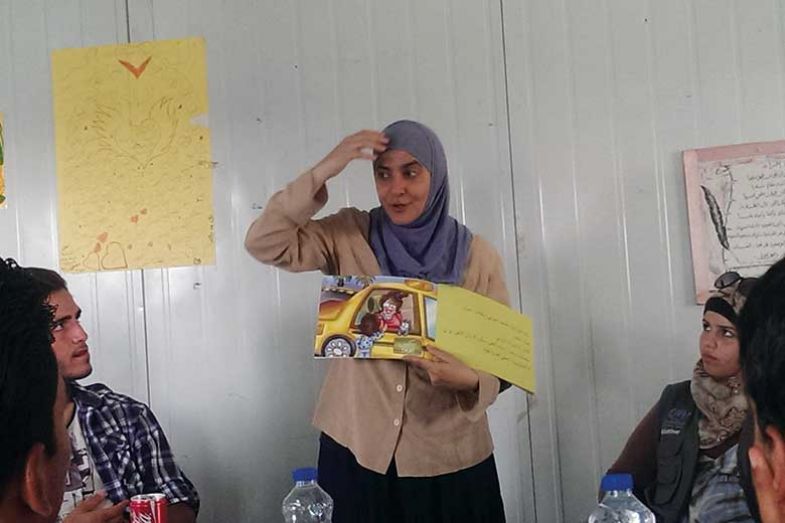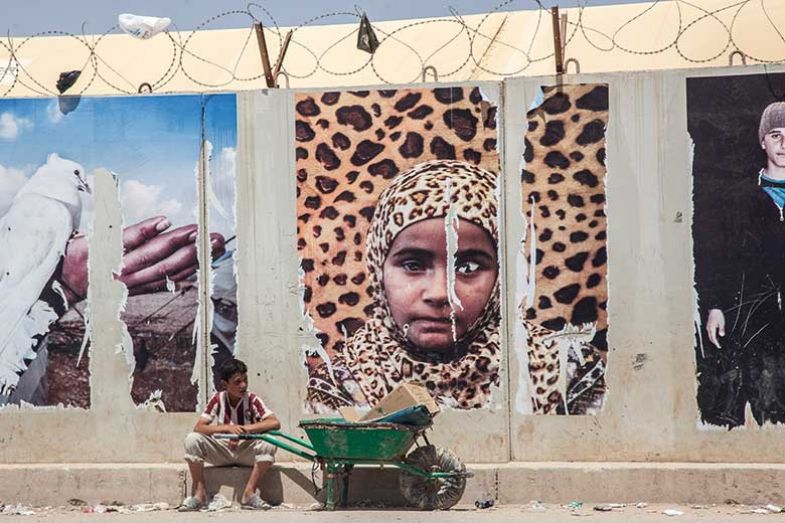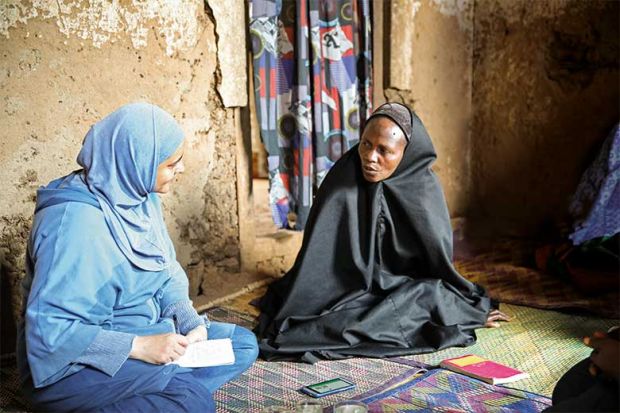In her recent book, Five Scarves, Rana Dajani describes herself as “half Palestinian and half Syrian with a Jordanian passport”, but also as “a global, cosmopolitan subject”.
She certainly stands at a crossroads of several worlds. A hijab-wearing molecular biologist who is now an associate professor at the Hashemite University in Jordan, she spent much of her childhood in the US, is perfectly bilingual, did a PhD at the University of Iowa and has held visiting positions at Cambridge, Harvard and Yale. Her scientific expertise is underlined by the fact that of the 53 scientific papers that Nature has published over the last five years with author affiliations in Arab countries, hers is the only one from Jordan (Saudi Arabia heads the list with 24).
But science is by no means the only arrow in her quiver. She has launched an online mentoring programme for female Arab scientists, the Three Circles of Alemat, while the non-governmental organisation she created to promote children’s cognitive development by reading aloud to them, known as We Love Reading, has worked all over the world, proving particularly transformative in refugee camps.
It is to this multiplicity of roles that the rather puzzling title of her book refers. Over the course of her life, as she sees it, she has worn five separate “hats” – or, as she’s a Muslim, “scarves”: that of mother, schoolteacher, scientist, social entrepreneur and fighter for women’s equality.
The subtitle of the book, Doing the Impossible, is scarcely more enlightening to the uninformed reader, while the sub-subtitle, If We Can Reverse Cell Fate, Why Can’t We Redefine Success? is even more puzzling. But all becomes clear in her preface. The point is that Dajani “grew up in a world where it was taken as a certainty that differentiated cells could never be transformed back into stem cells”, since “that would be almost like going back in time”. Yet it turns out that we can “reverse cell fate”. Could we not also “redefine success” and, in particular, “fundamentally transform the male-dominated, business-driven culture of our world to actually meet the needs of women and of all people”?
Here, Dajani believes the West has as much to learn from “the East” as vice versa. The book cites evidence that “women make up 64 per cent of [Jordanian] students in the natural sciences, medicine, dentistry, and pharmacy” as well as 60 per cent of engineering students in the Gulf (compared with only 30 per cent in the US and Europe). Furthermore, she adds, “Jordan, Qatar, and the United Arab Emirates are the only countries where women test better and feel more comfortable in mathematics than men, according to the OECD”.
Despite “a lot of stereotyping and propaganda [in other countries] about women and science in our part of the world”, Dajani tells Times Higher Education, she makes the bold claim that “in Jordan and the [Arab] Middle East, but also South-East Asia and even Africa, girls are interested in going into [science, technology, engineering and mathematics], and the parents and the community actually encourage them. Girls don’t feel intimidated in saying ‘We like science’, as they are in the West. That is where the West has something to learn. In the US and UK, the problem is getting girls to go into STEM…In our part of the world, it’s cool to be a mathematician and it’s something boys will respect…Women scientists from the Middle East and other regions of the world where they have also had relative success should be at the forefront of the global effort to improve conditions for all women.”
Cynics might suggest that one reason science is less popular among men in the Arab world is that it is so underfunded and underdeveloped. But Dajani insists that there has been “a huge improvement” in its quality since she returned to the country of her birth in 2005 and began working at the Hashemite University. Although the improvement is “not as fast as we might want…Jordanian science is doing very well regionally and picking up. PhDs are coming back and the ones who came back in the early 2000s are reaching senior positions, making the grants flow more easily.” Furthermore, local scientists show “a lot of stamina and determination and creativity to make things work” in environments where “maybe scientists in the West wouldn’t be able to survive”. When they are successful, it feels “like a plant in the middle of the desert”.
Yet Dajani also points to a number of crucial challenges. One is a combination of bureaucracy and lack of supportive structures: “If science is too rigid and too regulated, you are never going to get anywhere. It is bureaucracy that kills the development of science,” she says. Indeed, she goes so far as to assert that “the environment of research does not exist” in Jordan. “We don’t have lab managers. There are no postdocs. It’s only you and your graduate students and there’s a limit to what you can pay the graduate students and research assistants, which is not enough for them to stay in your lab for a long time,” she laments.
Another issue is what Dajani’s book calls “powerful norms of pedagogy” based on “rote memorization, obedience, passivity”. In her own classroom, she is committed to developing critical thinking and “turn[s] students upside down and make[s] them very uncomfortable, because they are using their brains in a very different way. They come out like new people, but the sad thing is they then go back to rote memorisation.” She takes comfort in recent developments such as the Phi Science Institute, a non-profit designed to “advance scientific potential and knowledge, among youth in Jordan and the Arab region”, and the Amman-based Institute for Critical Thought, which provides a space for creative and critical engagement with the arts, humanities and social sciences.
A more specific concern for Dajani is attitudes in the Arab world towards evolution. The default position among her incoming students is that the theory is in conflict with religion, although she argues that “it’s very important to understand why students…take this stand. There’s a history to it. Because of imperialism, Western countries used Darwin – social Darwinism – as an excuse to colonise, so there was an association between colonisation and Darwin and blasphemy…Nobody looked deeper. This is the association and it stuck.”
To overcome it, Dajani focuses on getting students to “look at the facts and how Darwin looked at them and come up with a theory to explain them. I tell my students: I’m not here to convince you, but to teach you how to be critical.”
In most cases, she claims, her students do come to accept the basic truth of evolution, although she worries that other lecturers, keen not to rock the boat, sometimes “don’t teach [evolution] at all, or teach it through rote memorisation, even at the university. They just provide very superficial facts.”

Given this somewhat dispiriting context, how has Dajani managed to break through and become a player on the international scientific stage? The key was finding a topic in which Jordan had a comparative advantage, but which was also of much broader significance.
In 2006, the Human Genome Project had just been published and Kári Stefánsson, a Harvard-trained Icelandic molecular biologist, was carrying out important work on risk factors for various diseases using the homogeneous genetic database in his native land. What Dajani realised was that Jordan, unlike most Western countries, had a couple of isolated endogamous communities, namely the Circassian and Chechen populations, which had immigrated there under military pressure around 140 years ago.
She began building genetic databases, focusing initially on diabetes since there is little stigma attached to the disease in Jordan. She formed a partnership with the Children’s Hospital of Philadelphia to carry out the DNA analysis, an unusual example of a long-term collaboration driven by the non-Western partner.
The project also required Dajani to overcome “hostility towards multidisciplinary work in Jordan” and bring together an anthropologist, an epidemiologist and a biochemist, as well as representatives of the two communities. The research uncovered “a novel genetic risk factor for diabetes type II in [those] populations that will benefit all humanity” via personalised medicine. It also provides new insights into “migration routes, when hepatitis B developed, and whether hunter-gatherers or farmers domesticated horses. With DNA you can do a lot!” she says.
The research led to the publication of a Nature paper, “137 ancient human genomes from across the Eurasian steppes”, last May, on which Dajani is one of 77 authors.
In her other ongoing research project, on “the epigenetics of trauma among Syrian refugees in Jordan”, Dajani again draws on specific (indeed, tragic) local circumstances to address issues of much more general concern.
The project “looks at psychology and mental health correlated to biomarkers, cortisol in the hair and the immune system”. It has strong policy implications, since the researchers can “study interventions by international NGOs, to see whether they alleviated mental distress”. They have also obtained data from three generations of women, the eldest caught up in a terrible massacre in 1980, in order to try to determine “whether trauma can be inherited genetically”.
“Inheritance of trauma has been shown in terms of behaviour but not epigenetics on the grand scale,” explains Dajani. “It’s been followed in some genes, but nobody has been able to design what we did – the history of the region allowed us to create this unique research project.”

Displaced: Rana Dajani’s research looks at the epigenetics of trauma in refugees such as those living in the Zaatari refugee camp in Jordan
Dajani is a well-known public figure in Jordan, partly because of the We Love Reading initiative, and has received awards for service to society and as a “star of science” from King Abdullah II. Although she could find a position in the US, she has “chosen to work and live in Jordan because it is where I belong and can make a difference”.
She denies that she has personally encountered any “sexist hostility” in the country (or anywhere else), and her “message to women” is: “Do what you feel comfortable with and don’t follow the stereotypes, or try to impress someone or get someone’s attention.”
Yet she combines this liberal position with a view unlikely to appeal to many Western feminists. While making clear that she is “not blaming women for men’s behaviour” and that “men should control how they behave and be held accountable for their behaviour”, she takes the perhaps provocative line that the hijab is empowering for female scientists.
“A friend of mine said to me that ‘Veiling is about unveiling my humanity,’” she recalls. “When women and men are working side by side, biologically we evolved to be attracted to each other. This has caused so many challenges. When I put on my veil, I am sending a message that I am here as a human being, with a mind and a personality, not as a shape, and I want you to respect me for that and to work with me on those terms. That’s the empowerment.”
Rana Dajani’s Five Scarves: Doing the Impossible: If We Can Reverse Cell Fate, Why Can’t We Redefine Success? was recently published by Nova Science Publishers.




